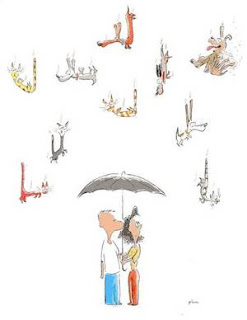Re-telling Jokes
from http://waze.net/oea

1. Copy a set of jokes (found below) and then cut them into strips of paper. Copy a table with a column for the jokes' names, heard, and told. Cut these into small rectangles.
2. Give a sample American joke – pre-teach blonde and the stereotypes associated with them. Pre-teach any other vocab from your jokes and explain the columns – they will read their joke, remember it (no reading!), then re-tell it to each other. They will mark “told” in the appropriate column. After they hear another classmates joke, they should mark “heard.”
3. If they hear a joke they like, they can tell that joke instead of their original joke. Continue marking their table so they can keep track of which ones they have heard.
4. Give them a good 15 minutes or so to mingle amongst each other and hear/tell as many jokes as possible.
The joke about the tiger
Two men are walking through a forest. Suddenly, they see a tiger in the distance, running towards them. They turn and start running away. But then one of them stops, takes some running shoes from his bag, and starts putting them on.
“What are you doing?” says the other man. “Do you think you will run faster than the tiger with those?”
“I don’t have to run faster than the tiger,” he says. “I just have to run faster than you.”
The joke about the genie An Australian is sitting at a bar, and he sees a lamp on a table. He picks up the lamp and rubs it, and out pops a genie. It says, “I will give you three wishes.”
The man thinks for a while, then he says, “I want a beer that is never empty.”
The genie waves his hand, and a bottle of beer appears on the bar. The Australian starts drinking it. When it is almost empty, it starts to refill. The man is very happy. The genie asks about his next two wishes.
The man says, “I want two more of those.”
The joke about the ugly son
There was a man who had four children, all extremely good-looking, except for the youngest one, Craig. Craig was quite ugly!
The man grew old, and just before he died he asked his wife, “Mary, I have only one question. Please tell me the truth. Am I Craig’s father?”
“Yes, my dear,” replied his wife. “I promise you, Craig is 100% yours.”
The husband smiled. “I can die a happy man. Goodbye, my love.” And he peacefully passed away.
Mary gave a big sigh and said, “Thank god he didn’t ask me about the other three.”
The joke about the smart dog A man went to visit a friend, and was surprised to find him playing chess with his dog. He watch the game in amazement for a while.
“I can hardly believe my eyes!” he said. “That’s the smartest dog I’ve ever seen!”
“Oh, he’s not so smart,” the friend replied. “I’ve won four games so far, and he’s only won two.”
The joke about the cute dog
A man walks into a shop and sees a cute little dog. He asks the shopkeeper, "Does your dog bite?"
The shopkeeper says, "No, my dog does not bite."
The man tries to pet the dog and the dog bites him.
"Ouch!" he says. "I thought you said your dog does not bite!"
The shopkeeper replies, "That is not my dog!"
The joke about the robber One night, Tim was walking home, and all of a sudden a robber jumped on him. Tim and the robber began to fight. They fought and fought, but finally the robber managed to pin him to the ground. He searched Tim’s pockets, but only found 25 cents. The robber was so surprised that he asked Tim, “Why did you fight so hard for just 25 cents?”
Tim said, “I thought you wanted to steal the $500 that I’ve got in my shoe!”
The joke about the pool A beautiful woman walked into an orchard (果园) and found a lovely pool. It was a hot day, and she decided to go for a swim. She looked around, but didn’t see anybody. So she took off all her clothes. She was just about to jump into the pool, when a man suddenly appeared. He was the owner of the orchard, and he had been hiding behind a tree!
“This is my orchard, and swimming in the pool is prohibited (禁止),” he said.
“Well, you should have told me that before I undressed,” said the woman angrily.
“Swimming is prohibited,” he replied, “But undressing isn’t.”
The joke about the blonde A blonde woman goes to work one day, crying. Her boss asks her why she’s crying, and she says that she just heard that her mother had died. The boss tells her to go home and rest, but woman wants to continue working so that she won’t think about the sad news too much.
A few hours later, the blonde receives a phone call. Afterwards, her boss hears her crying again. He goes and asks her what has happened. She says, “It’s so sad. My sister just called, and told me that her mother has died too.”
HANDOUT A SMALL TABLE TO EACH STUDENT
| The joke about… | Heard | Told |
| the tiger |
|
|
| the ugly son |
|
|
| the smart dog |
|
|
| the cute dog |
|
|
| the robber |
|
|
| the genie |
|
|
| the pool |
|
|
| the blonde |
|
|





















